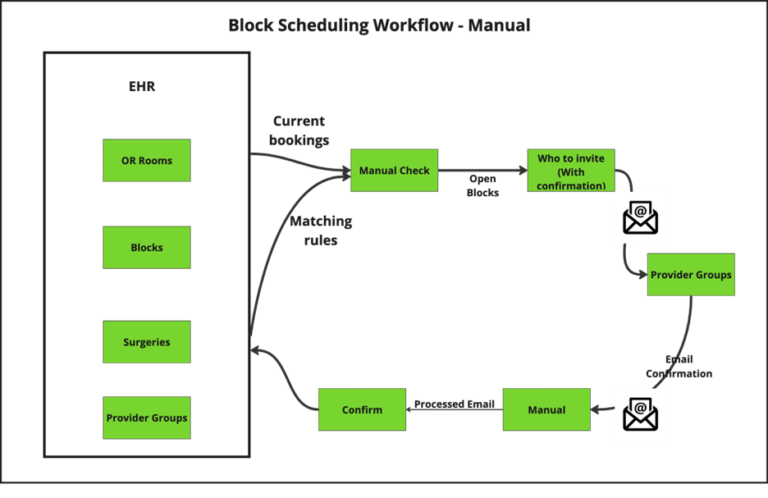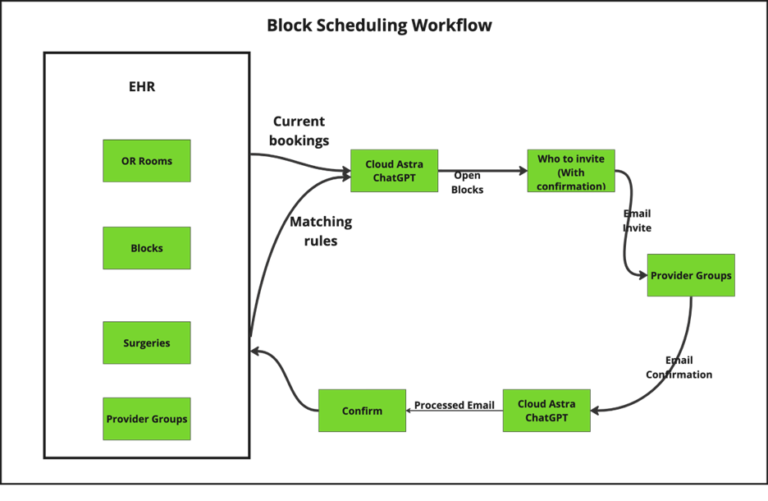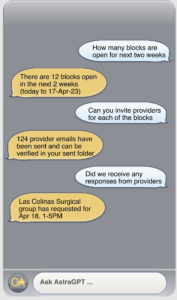You could save over a Million dollars by orchestrating OR Block Scheduling with AI and ChatGPT
You could save over a Million dollars by orchestrating OR Block Scheduling with AI and ChatGPT

What is block scheduling?
Hospitals set up OR time in blocks and allocate to internal and external provider groups. This lets the hospital leverage all available resources to book slots in the OR so they can optimize the return on investment in the expensive facilities needed for an OR department
How do blocks get setup?
Typically, hospitals allocate their blocks to provider groups for a contracted period. These blocks are typically in high demand as setting up and operating ORs is a capital-intensive exercise. When a new provider group needs a set of blocks or when existing providing groups request additional blocks, it is very difficult to get a promised long-term slot as they are typically booked for several months
Why is block utilization low?
The premise that preassigned blocks are in large demand and thus difficult to obtain would lead one to conclude that most hospital OR blocks would be completely utilized and the OR utilization at least in prime hours would be close to full capacity.
However, that is not the case. This is typical because the provider groups that have been assigned long-term slots may not be able to book enough surgeries to fill in the slots. In that case, they could come back to the hospital system and let them know of their inability to fill the slots. In other cases, the provider groups could have other reasons for some of these slots getting canceled and it could be either some scheduling issue with the provider group or with the patients.
What happens currently
When a hospital realizes that a block is going to be empty, the OR schedulers now need to find alternate provider groups that can fill in the slots. This is a mostly manual process where the OR schedulers reach out to provider groups either via the phone or SMS
What is the problem with a manual system?
Time consumed
There are several issues with manual systems. The first is the time that is spent on each booking. Since multiple emails / SMS messages need to be sent to provider groups and in some cases, provider groups may need to be identified as potential targets, the manual process is very inefficient and time-consuming.
OR managers out of the loop
Since the scheduling of these blocks is now a manual process, OR managers do not typically have up-to-date information. They need this to plan for staff and other resources and random blocks that go unutilized is not welcome news for OR managers.

Why fix this?
It is economical and will save money
Fixing the manual prior authorization process will save time and money. Imagine the job of an OR scheduler that needs to schedule 10 operating rooms. Considering 4-6 hour blocks, they would need to manage a total of (10x8x5) = 400 hours, divided by 6 would be around 66 blocks a week. If 10-12 of these blocks get released and 5-10 alternate provider groups need to be invited, that is around 120 emails that need to be typed up and sent out. This is further complicated by the fact that certain ORs may not be applicable for certain provider groups, provider groups could have preferences for invitations only on certain weekdays, so they would not want to get spammed on days they are not interested in booking.
Reduce staff burden
The automation of the block scheduling process will reduce the burden on hospital staff. As we have seen hundreds of emails need to be sent out and responded to and more importantly the recipient list needs to be adjusted by a variety of criteria. This is time-consuming and places an enormous burden on the scheduling staff.
Improve revenue
By far the biggest incentive for the hospital is to recover revenue that is otherwise lost.
Operating rooms cost anywhere between $22 to $133 per minute. If we take an average and consider a cost of $77.5 per minute, a single 6-hour block every week can net the hospital 6x60x77.5 = $27,900 a week. Over a one-year period (52 Weeks) that could be a total savings of $1,450,800 (Close to 1.5 Million dollars).
Patient Satisfaction
Quick scheduling of surgeries is beneficial to patients and efficient processes have a large downstream effect on patient satisfaction. When blocks are scheduled efficiently it is possible that patients may not have to wait for days to get their surgical procedures scheduled.

How can AI and Generative AI products help
Although several traditional block scheduling solutions exist in the market the advent of generating AI could be a game changer. Imagine if the OR scheduler can interact with a trained bot that can answer questions like
- What blocks are open for the next 2 weeks
- Who can I invite for these blocks
- Can you type up emails for each of the blocks and invite the groups you suggested
- Has anyone replied to our block requests
- How many blocks have you booked over the last two months
- How much money have you saved us
- How much time have you saved us
The use of generative AI will be transformative in different areas of the healthcare system, but logistical coordination activities such as Block Scheduling and Nurse Scheduling that involve a lot of spreadsheets, emails, and manual activities are an ideal place to start.
Watch for more blogs from us in the areas of nurse scheduling, prior authorization, and more.

Contact Us
Let us innovate together. If you are interested in exploring this further contact us at https://cloudastra.ai/contact-us
